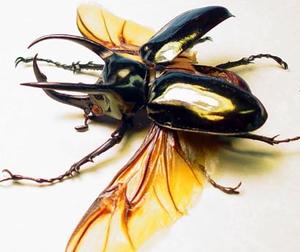AviationRhinoceros beetles foretell future of flapping-wing design
Researchers launch a quantitative investigation of aerodynamics and wing kinematics in rhinoceros beetle flight in order to shed new light on the evolution of flapping flight in nature; experimental study of the aerodynamic performance of beetles in forward/hovering flight will provide insight into designs for efficient and stable flapping-wing micro aerial vehicles

Rhinoceros beetle with wings displayed // Source: etsy.com
Rhinoceros beetles could play a big part in the next generation of aircraft design with the help of researchers in Drexel University’s Mechanical Engineering Department. Dr. MinJun Kim, an associate professor in Drexel’s College of Engineering, is leading a team of engineers in National Science Foundation-funded research that examines the function and aerodynamics of the Allomyrina dichotoma beetle in collaboration with Konkuk University in South Korea.
A Drexel University release reports that Kim’s research aims to study the movements of a beetle’s wing by controlling its motion remotely via four tiny electrodes implanted in its body. The team then films the flight of the beetle from take-off to landing while electrical currents direct the extension, contraction, direction and flapping frequency of the wings. The use of a wind tunnel allows the researchers to see how air currents move around the wings they flap during flight.
“A quantitative investigation of aerodynamics and wing kinematics in beetle flight will shed new light on the evolution of flapping flight in nature,” Kim said. “Furthermore, experimental study of the aerodynamic performance of beetles in forward/hovering flight will provide insight into designs for efficient and stable flapping-wing micro aerial vehicles.
In the rhinoceros beetle, which is indigenous to South Korea and can be brought to the United States for research purposes under special approval from the U.S. Department of Agriculture, Kim’s team has found what could be the perfect candidate for the controlled study of biological flight capabilities.
The beetle’s size, 7-9 centimeters as an adult, is large enough to allow engineers to implant electrodes, in both optic lobes, the central nervous system and abdomen, without harming it. It is also a powerful flying creature for its size, having the ability to take flight directly from the ground — which is rare among smaller insects.
“Use of biologically inspired approaches in the aerospace engineering community, motivated by an interest in micro aerial vehicles, has been increasing rapidly,” Kim said. “Although microfabrication techniques are advancing, it remains a challenge to fabricate separate individual machinery parts and develop millimeter-scale battery systems for aerodynamic maneuverability. An alternative approach is to directly utilize the insect itself. They are easily ‘manufactured,’ and — by nature- self-contained and easy to fuel.”
Kim, who is an associate professor of mechanical engineering, focuses his research on fluid mechanics at low Reynolds numbers. He also examines natural biological transport phenomenon and single molecule biophysics.
